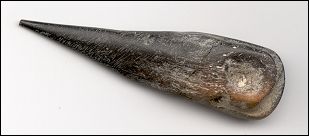

Archaeologist or paleontologist? Or is there a difference? One burden borne by both of these professions is the widespread confusion over what they do. Archaeologists deal with human prehistory, while paleontologists deal with fossils. Both, in a sense, are detectives, piecing together the past from evidence found today.
The archaeologist attempts to decipher the human past from purposely chipped stones, pot sherds, subtle differences in soil color or texture, and other such clues. Alas, the days when a person could be an expert in an entire field are gone forever. Although human cultures have many things in common, cultural diversity is rampant—an Egyptologist is little more competent to discuss the archaic Native American cultures of this region than is an East Coast gardener dependable for advice on native plant gardens in our desert.
Blest with at least 11,000 years of prehistory, our Chihuahuan Desert
has literally thousands of archaeological sites awaiting study—sites that reveal the
conspicuously human trait of adaptation to a wider suite of habitats than any
other animal.

Listen to the Audio (mp3 format) as recorded by KTEP, Public Radio for the Southwest.
Contributor: Arthur H. Harris, Laboratory for Environmental Biology, University of Texas at El Paso.
Desert Diary is a joint production of the Centennial Museum and KTEP National Public Radio at the University of Texas at El Paso.

A prehistoric awl made from part of the foot of a deer (the distal end of a metapodial). The portion on the right is where one of the two main toes that occur on each foot would attach. Some of the marks made during the grinding of bone can be distinguished on the left portion.
Cordell, L. 1984. Archaeology of the Southwest. 2nd ed., Academic Press, Inc., San Diego, 522 pp.
Reid, J. J., and D. E. Doyel, editors. 1986 (second printing 1992, with updated bibliography). Emil W. Haury's prehistory of the American Southwest. University of Arizona Press, Tucson, 508 pp.